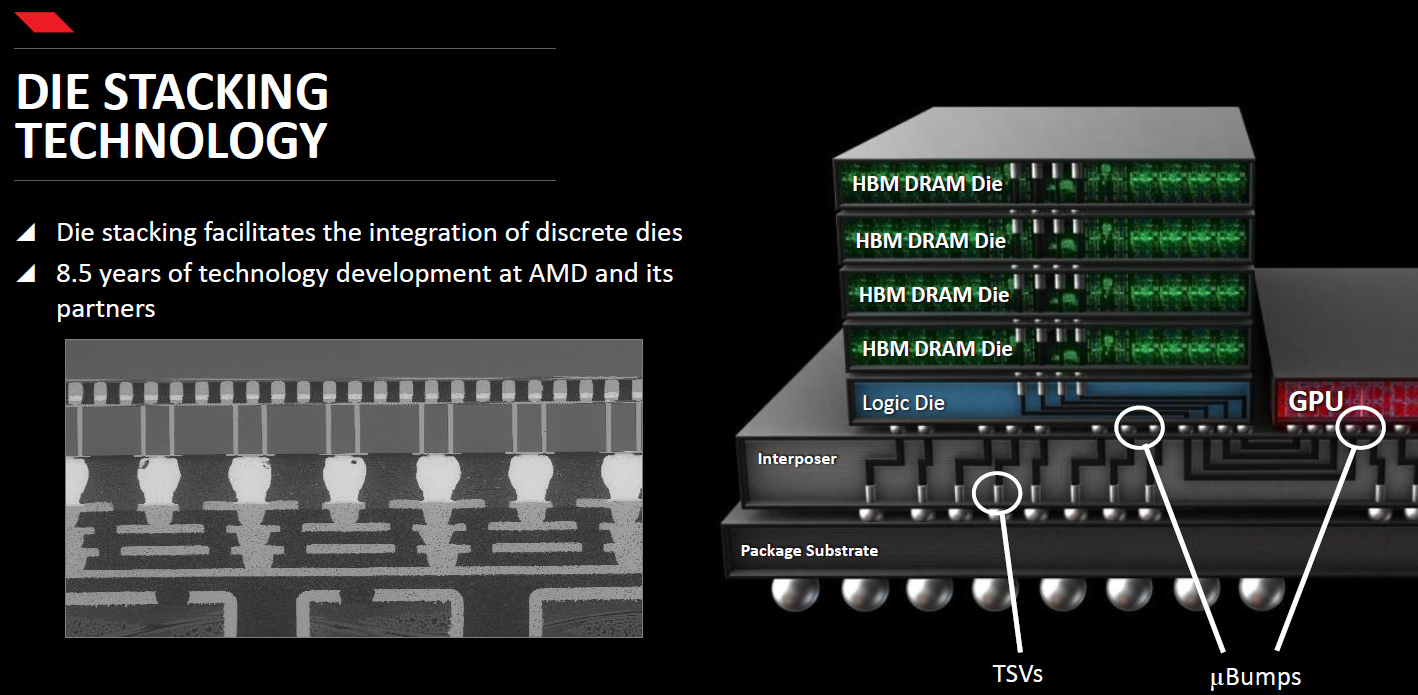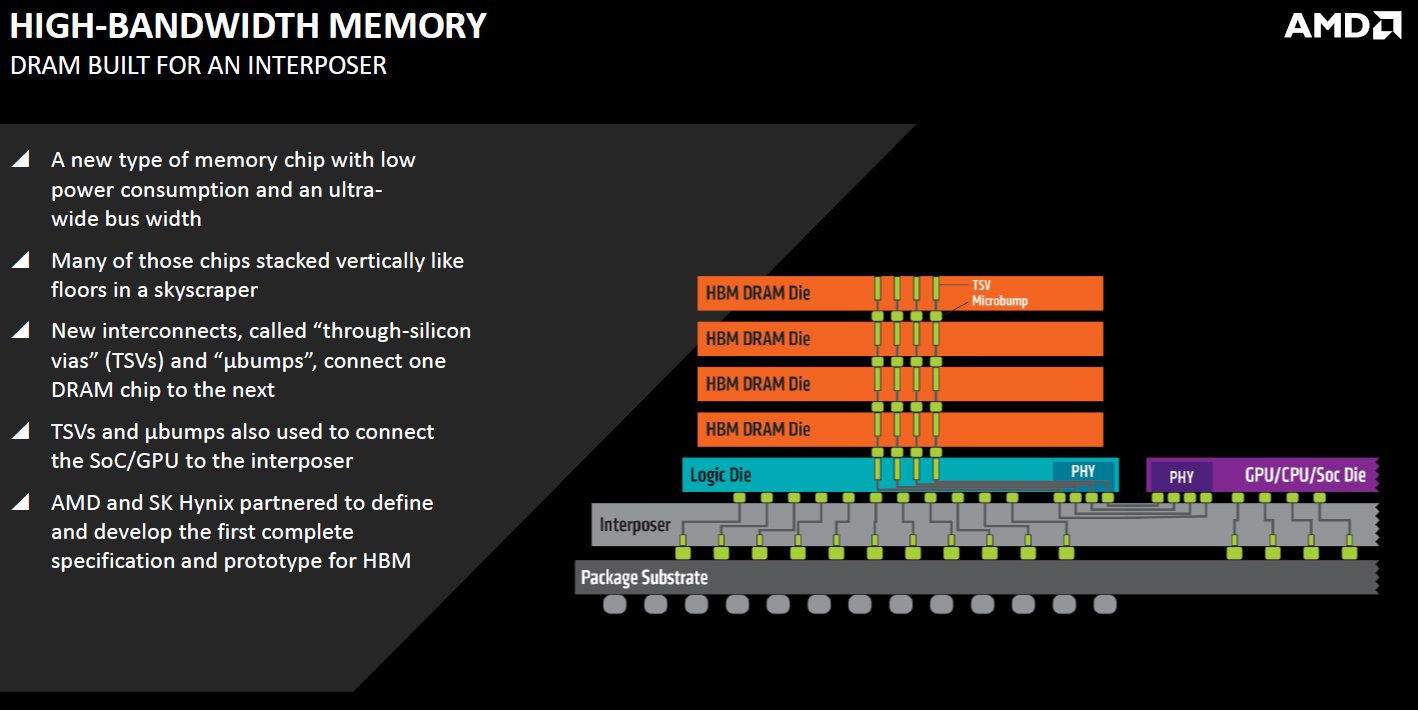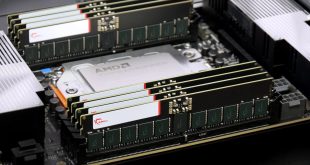Advanced Micro Devices is currently the only company to use high-bandwidth memory it co-developed with SK Hynix and other partners. While usage of HBM is clearly a competitive advantage that AMD has over its rivals, the company is encouraging others to use the new memory type and does not intend to collect any royalties for HBM.
It has taken AMD over 8.5 years to develop high-bandwidth memory and a set of technologies that enable new DRAM chips as well as their interface with host processors. In a bid to make HBM memory more affordable, more developers of graphics processors and other bandwidth-demanding chips have to use this technology. Once HBM gets less expensive than today, the industry in general will benefit from this.
Nvidia Corp. has publicly revealed that its next-generation “Pascal” architecture of graphics processors supports second-generation HBM memory and in 2016 graphics cards with GP100 GPUs and HBM2 DRAM will hit the market. In fact, HBM support is a key feature of Nvidia's “Pascal”, which will help the company to triple the bandwidth available to its next-gen GPUs, thus significantly improving their performance.
Earlier this week a web-site reported that Nvidia will delay adoption of HBM because of royalties demanded by AMD for its HBM-related intellectual property. In particular, it is reported that 2.5D GPU packaging used for the “Fiji” graphics processing unit is covered by AMD’s patents and Nvidia either needs to design its own package or pay licensing fees to its rival. According to AMD, this is not true.
“AMD is not involved in collecting any royalties for HBM,” said Iain Bristow, a spokesman for AMD. “We are actively encouraging widespread adoption of all HBM associated technology on [Radeon R9] Fury products and there is no IP licensing associated.”
Advanced Micro Devices owns a number of patents covering HBM, but as that intellectual property is a part of JEDEC’s JESD235 standard, it has to be licensed to applicants desiring to implement the standard “either without compensation or under reasonable terms and conditions that are free of any unfair discrimination.” Moreover, AMD and Nvidia have a broad cross-licensing agreement, which largely prevents royalty demands.
Nvidia did not comment on the news-story and called the information “rumours and speculation.”
Discuss on our Facebook page, HERE.
KitGuru Says: Adoption of HBM memory by Nvidia may be slow-downed not by AMD, but by availability of second-generation HBM. Perhaps, SK Hynix and Samsung Electronics will only release next-gen HBM in the second half of 2016, which means that HBM2 will be available in mass quantities only in 2017.
 KitGuru KitGuru.net – Tech News | Hardware News | Hardware Reviews | IOS | Mobile | Gaming | Graphics Cards
KitGuru KitGuru.net – Tech News | Hardware News | Hardware Reviews | IOS | Mobile | Gaming | Graphics Cards






Amd seriously needs to start doing stuff to help it’s budget
Will Nvidia pascal have 3.5gb of hbm2 memory? (never forget…)
48GB now that Samsung’s stepped in and completely outclassed Hynix’s offerings.
the gtx 970 remains the best selling card for nvidia.
That’s was rumor taken out of context
No it wasn’t. Consumer Pascal will top out at 24GB. Professional/Enterprise will top out at 48.
The thing was that Hynix can get 48 too, Samsung don’t outclassed nothing, going to search for the source.
“KitGuru Says: Adoption of HBM memory by Nvidia may be slow-downed not by AMD, but by availability of second-generation HBM. Perhaps, SK Hynix and Samsung Electronics will only release next-gen HBM in the second half of 2016, which means that HBM2 will be available in mass quantities only in 2017.”
I SINCERELY hope you’re kidding. Samsung is the one that said that they’d begin HBM2 production in 2016, but didn’t specified when. And both AMD and Nvidia have confirmed their next-gen cards for next year.
Hynix has to go 6 stacks to do it. Samsung only needs 4. Samsung has their density and bandwidth beaten by 50%.
Thats all good but mine still has 3.5gb of gddr5 instead of 4GB.
And I was mislead by false advertising when buying it… So… I have a right to be mad and, as long as I have a viable option I will not buy nvidia again…
🙂
No it wont. :))
“The world’s largest maker of dynamic random access memory (DRAM) did not unveil any details about its actual HBM chips (capacities, clock-rates, etc.), but expect a family of products with different densities and frequencies.”
http://www.kitguru.net/components/graphic-cards/anton-shilov/samsung-expects-graphics-cards-with-6144-bit-bus-48gb-of-hbm-memory-onboard/
Kitguru fell behind. Samsung did confirm. http://hexus.net/tech/news/ram/85751-samsung-start-hbm-mass-production-early-next-year/
Yes both Hynix and Samsung will start mass production of HBM 2 somewhere at 2016. Regarding 48GB, 1.5TB/Sec HBM2 Samsung nowhere states will produce at 2016. Samsung expects HBM 2 to scale up 48GB.
“Overclockers dream”
“4 GB HBM is plenty for 4”
Says hi
If you think that’s not its opening move to capture the high-end market from Hynix, you’re naive.
Don’t expect Nvidia to ever return the favor. And if the shoe were on the other foot, Nvidia would probably prevent AMD from using HBM.
Do you know Hynix had any opening move or not ??
“Moreover, AMD and Nvidia have a broad cross-licensing agreement, which largely prevents royalty demands.”
Did you read the article?
Hynix already bled its hand thinking 32GB would be enough at 1.0TB/s and 1.2V. Samsung’s beaten that across the board with 48GB at 1.5TB/s at 1.15V.
It’s not a bad card, but that was still a crappy thing for them to do. Hopefully they won’t repeat that mistake.
I’m actually a little disappointed to hear that AMD’s not collecting HBM royalties. They could use the money to shore up their R&D so they can compete better. I do not want Intel and Nvidia being monopolies, not matter how much I like their products.
And I put my money where my mouth is and buy AMD products too. I’m not one of those well-wishers who keep buying Intel/Vidia and just hope that AMD will prosper. I know it doesn’t work that way.
“Samsung’s beaten that across the board with 48GB at 1.5TB/s at 1.15V.”
How do you ascertain that ??
*again
Like this technology was created solely by AMD. AMD has a very, very low R&D budget considering the product range the company offers. To get around this, AMD “partners” with other companies to help them develop new technologies. AMD does this a lot. For instance, with the two new consoles, the APUs development cost was paid for by MS and SONY, rather than AMD.
I doubt AMD put in more than 20% of the cost of developing HBM but since it was first to market, everyone assumes that “AMD made it”. Like DRAM DDR3 and USB, this is a simply a industry standard which is why AMD cannot charge royalties.
The worst of it was that AMD was too quick to market and could only squeeze in enough memory to run most high end games poorly. It should have waited and used the full potential of HBM when it did not cost so much to make and could have doubled the memory. These high end cards are not bought without a lot of scrutiny by the consumers and the reviewers all made disparaging remarks about the lack of memory and this did not help sales.
Frankly, no one really cared about “memorygate” which was nothing more than a wording issue. Yes, it made the tech news but most people who buy mid range graphics cards look at what is selling well and what the reviews for it are. The reviews were all extremely positive. On Amazon, the NVidia GTX970 has been their number one best selling card for over a year now, and for good reason. It is a great card for the money.
http://www.amazon.com/gp/bestsellers/electronics/284822/ref=sr_bs_1
Because Samsung already announced that chump, as I’ve provided sources for several times now.
No it wont. 🙂
“The world’s largest maker of dynamic random access memory (DRAM) did not unveil any details about its actual HBM chips (capacities, clock-rates, etc.), but expect a family of products with different densities and frequencies.”
http://www.kitguru.net/components/graphic-cards/anton-shilov/samsung-expects-graphics-cards-with-6144-bit-bus-48gb-of-hbm-memory-onboard/
Yes it will. http://m.hexus.net/tech/news/ram/85751-samsung-start-hbm-mass-production-early-next-year/
I bought one and i am very happy with it.It’s more or less a stock 980 when you OC it.
You are such nvidia shill that writes complete absolute garbarge pulled out of your ass. i wont even waste my time writing why every single thing you wrote is absolutely false and made up by you and your feelings
Yes both Hynix and Samsung will start mass production of HBM 2 at 2016. Regarding the 48GB 1.5TB/Sec HBM2, Samsung nowhere states they will produce them at 2016. Samsung expects HBM 2 to scale up to 48GB 1.5TB/Sec, same thing as KitGuru said.
And this is one of the reasons why I love AMD, took them 8.5 years to develop HBM and still they don’t want any royalties and encourage others to use it, they do innovative things and care about the industry as a whole. Imagine if NVIDIA made something like this, they would have kept it to themselves like the selfish company they are.
Oh please that’s a lawyer’s dodge and you know it. Pascal is Nvidia’s next big compute architecture, so the 48GB models will come into play without a doubt.
Care for the greenteam to say thank you to the red team??? Wait a sec, they are too fanboi to even admit that AMD tries to innovate for free!!!! If I were AMD, I would tell Nvidia, F-Off and make your own memory desighn/interface. Stupid AMD.
This guy is a Nvidia Shareholder, you can tell….. lol. So you are belittling what AMD put for R&D even though it’s about 20% or less for HBM technology? Wait a sec, so Nvidia, put what? I forgot Nvidia didn’t do sh!t to improve HBM technology. They are getting it more than likely for free. Even if you say they didn’t really spend a lot. It’s the idea that matters. I sometimes wonder; when I read your comments, when the heck were you born?
Ideas comes a long way. Hooray AMD. Screw Nvidia. I would never buy their cards again. I had never ending issues one after another. I thought my system was shit. So totally upgrade to another, and there you go again, driver crashes and BSOD later on.
So I said, for the third system, why not, try AMD, Booyah! Scored, Pretty solid for AMD card now. No stupid driver crashes and BSOD. I hate how NVIDIA is so manipulative freak they have become.
John Pombrio your are ID10T. There’s no room for a stock holder like you in tech site just to bring another company down so you can collect your crazy ass money dividends from Nvidia. Just hush and drink your coffee and be happy collecting your dividends from Nvidia. I hope Nvidia loses their ground in GPU market. With their crazy ass codes that forces older GPU users to dump old GPU to buy a new GPU. Lol AMD GCN 1.0 will be performing really well in DX12; for Nvidia…..hmmmmppp sorry boys you are forced to update and buy new cards for DX12 games coming up.
“so the 48GB models will come into play without a doubt.”
Not confirmed for 2016 at least.
Na yours had 4GB of memory the last 512mb of it is segmented if the card was marketed as 3.5GB of Vram it would still perform the same in all benchmarks and you still would have bought it. If 512MB breaks your game then neither 970 or the 980 is the right card for you
I was under the impression it was somewhat to even overclock HBM with Amd? Also when does 512mb break a game?
Everyone knows that the last 512mb preform alot worst then the 3.5gb. I notice a tremendous difference in GTA V when I push the settings and they use the 4gb. But, still, that is not the point… Legaly it’s just an aberration what they did… I’m sure you would be pissed of if you bought 1ltr of milk and it had 200ml of water… You could still drink it but it wasn´t the 1ltr of milk you bought and it was advertised to you… Another example, you could buy a lambo with 600bhp and after you bought it you realised that it only had 500bhp and 100bhp of power you could use but it will make your car perform like a fiat500, ofcourse you could be amazed with the 500bhp, but you bought a lambo with 600bhp why would you be happy with 500bhp and 100bhp of power you would never be able to use it at it´s fullest… I´m not complaining about the card’s performance, im complaining about being tricked…
I game at 1440P on my 970 just fine hell most of my games don’t even use 3GB of Vram and most games are starting to not even look much better at ultra vs medium-high.
That is not the point my friend… 🙂 i’m happy with performance even with hynix memory instead of samsung… the point is in buying something that was bad advertised… If it says in the box 4GB of gddr5, you should get 4GB, not, as they said after this exploded, 3.5 + 0.5… A company like nvidia doesnt make this kind of mistakes… It was a calculated, marketing move… wich is wrong… 🙂
So, nobody really cared about “memorygate”, eh?
https://www.youtube.com/watch?v=tNGi06cq_pQ
I guess people went to the trouble of making videos like this because it was no big deal to be shafted like that. The point was the deception, in case you’re wondering. If a company says a product has 4GB of memory, and only four months of brisk sales, and only after several independent testers out you, you FINALLY admit that yes, .5GB of the ram runs at only 1/7th the speed of the rest of the memory, because it allowed you to boost your profit margins even higher to make the memory controller work that way, instead of using a proper, full-speed memory contoller, you’re a cheating, thieving bastard, and you don’t get money for that. For many who bought a GTX970, that’ll be their last nVidia card.
Neither AMD nor nVIDIA or any company invent any think. it is Jobs who invented this world and every thing in it all the matter is that AMD discovered one of his inventions so no one has the right to collect royalty fees except for the rounded square off Apple.
Any reviewer who said it didn’t matter was either crazy or biased to nvida. Claiming it has 4 when it really 3.5 is SCAMMING. Claiming it has “full dx12 support” when it only has software support is SCAMMING. Nvidia literally scammed those people.
It’s pretty much guaranteed.
By how ??
Much kappa much wow
Because Samsung has always led on DRAM density. Even now both in GDDR5 and DDR4, no one makes RAM chips with capacities as high as Samsung’s.
HBM is a different device fatty and Samsung had no manufacturing experience with HBM compared to Hynix.
Regarding the 48GB 1.5TB/Sec HBM2, Samsung nowhere states they will produce them at 2016. Samsung expects HBM 2 to scale up to 48GB 1.5TB/Sec, which is just hypothetical projection.
Not stupid AMD, altruist AMD, it’s their philosophy.